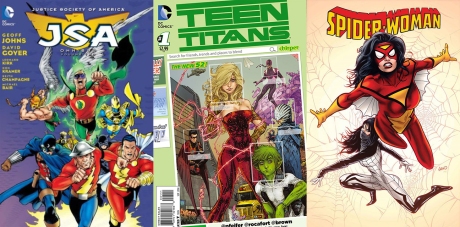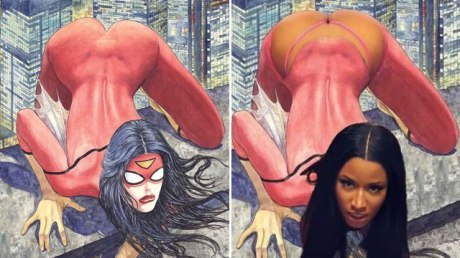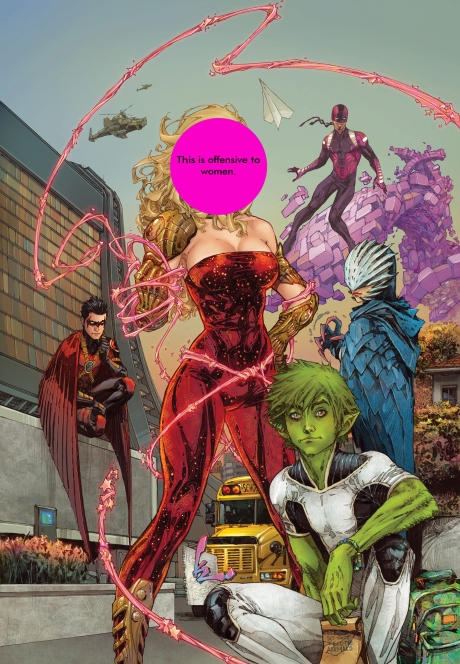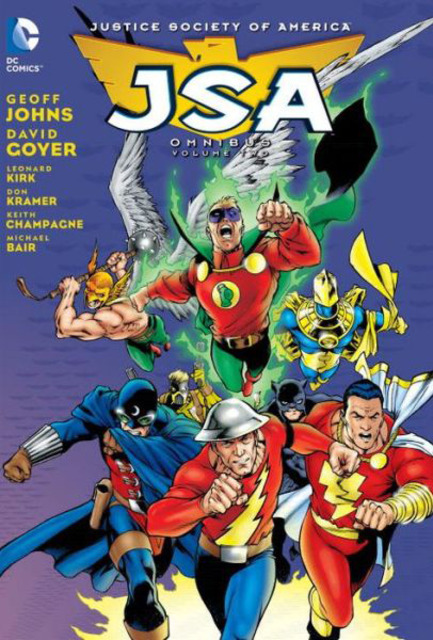2014 was an interesting year for comic book covers. Some Vertigo titles experimented with putting the first panels of the story on the cover. Independent publishers like Image Comics, Top Shelf, and Oni Press drew inspiration from wells outside of traditional comics to unleash some phenomenal design and the Big Two continued to offer loads of variants while still ruining covers by filling them with ads for movies and TV shows. Convention floors, the blogosphere, and comic book shops had readers and creators discussing the merits of covers while speculators looked for hidden Easter Eggs and social activists looked for opportunities to progress a higher discourse. Two covers in particular stirred more conversation in 2014 than all others. The re-reboot of Teen Titans and a reboot of Spider-Woman faced resistance specifically from critics for whom the representation of women is elemental to their comics critique. Here I will discuss both those covers and the cover of the second volume of the Justice Society of America omnibus. Before I begin, let me just admit that my white male privilege allows me to write this article without fear of rape or death threats. It’s disgusting that we live on an internet where a noticeable portion of its populace respond to ideas they find threatening with threats of physical violence. The fact that such behavior finds a home in discussions about comic books is especially sad- what would Superman say if he saw you writing rape threats to a stranger because of her opinion on a comic book cover?
For the first issue of their latest Spider-Woman reboot, Marvel recruited the talents of Milo Manara, an Italian comics creator known for his hyper-sexual style. Full disclosure: I’m not a Marvel reader and don’t have any emotional ties to Spider-Woman as a character. I am however a fan of erotic art and have an appreciation for low brow art. I also appreciate the long standing tradition of sequential art itself as a marginalized art form. When I heard an esteemed erotic artist would provide art for a mainstream variant comic book company, I thought it sounded like a cool idea. I love diversity among artists and believe comics generally benefit from outside influence. For example, I think the Scribbenauts variants and most of the Robot Chicken variants that DC’s been using look pretty dumb, but I appreciate that such distinct styles are been experimented with and I like to see a wild mix on the comic book shelves. Still, much of the controversy had little to do with those few defenses I just offered, but rather focused on the use of such an artist to promote a book that had been admittedly targeted towards women and on book about a character that many female readers had identified as an example of progressive representation. A lot of male readers and the creators responsible for creating it took the criticism very personally.
Some readers found humor in the controversy.
Some readers got scientific.
News operations outside of the world of comics like TIME magazine even picked up the story, reporting on the cover controversy and supplying Marvel with a bit of free publicity.
The other cover that drew a great deal attention is the first issue of the re-rebooted Teen Titans. Unlike Spider-Woman, the Teen Titans are characters that I do follow and for whom I have developed some sentimental attachment. The controversy over this cover began when former Bat-title editor Janelle Asselin wrote an article about its cover where she described it as “not just a terrible comics cover, it’s a prime example of how even the most corporate comic book companies can make basic mistakes regarding the potential audience for a book.” I have a little trouble with her describing it as a “prime example” as it seems as if she picked it arbitrarily. Her critique of the cover is largely valid; I just think it can be applied to scores of other covers that supply greater evidence to support her criticism. You can read her original article and you won’t find anything too confrontational. You might feel a little bad for Kenneth Rocafort being singled out for a trend and tradition in comics that is much larger than his own contribution to the medium, but Asselin articulates pretty clearly in her article that her intention is not to attack the artist.
Asselin’s complaints are in some ways more justified than those made against Spider-Woman and in some ways less. For example, Spider-Woman is a variant cover and this Teen Titans cover is the official cover. On the other hand, the Spider-Woman cover is explicitly sexual while the Teen Titans cover more subtly directs attention towards Wonder Girl’s breasts. Both Asselin’s critique of this cover and the general complaints about the Spider-Woman cover made specific points about how the two books are targeted somewhat to female readers. In that instance, the real criticism is “hey comic book companies, you’re marketing your books poorly!” not “hey comic companies, you’re perpetuating a hate crime!” Disgustingly some of the public responded the criticisms as if they had been the latter “hate crime” accusation by responding themselves with very hateful speech and even threats of physical violence. Coupled with the species-wide embarrassment that was Gamergate, geek males looked really bad in 2014. Not simply because they acted like monsters towards others, but they demonstrated such resistance to advancing the mediums they purport to love. Of course, this demented vocal element of the comics reading community represents only a small portion of that community. Neither the critique against Spider-Woman nor the one against Teen Titans were revolutionary nor were they particularly sophisticated, but they absolutely belong in our discussion of comics which makes the toxic reactions so absurd. I find Asselin’s critique to be somewhat arbitrary and forced. I find the controversy over Manara’s Spider-Woman a little dumb because 1) it’s a variant cover, not the official cover 2) it’s painted by an erotic artist with the intention of being hyper-sexual, so being upset with it parallels hating ice cream sandwiches for being delicious. Still, both critiques have value. Now I would like to present a critique of the cover used for the second volume of the JSA omnibus that requires less nuance to explain.
First, let’s look at the cover:
For the cover of the omnibus, DC Comics decided to use the wrap around cover from JSA #50, an iconic cover featuring most of the primary players in the series. In terms of aesthetics, I think DC could have used better images for both volumes, but this isn’t a discussion of aesthetics. As you can see, the characters that appear on the front cover are Green Lantern, Dr. Fate, Wildcat, Captain Marvel, the Flash, Dr. Mid-Nite, Sands, and Hawkman. These are all important characters though some are more prominent than others. Two things that the characters all have in common are their race and gender.
Second, let’s look at the full image from JSA #50‘s wrap around cover to see what other members of the Justice Society appear on the back:
Here we see the rest of the team: Atom Smasher (white male), Power Girl (white female), Hawkgirl (white female), Black Adam (middle eastern male), Mr. Terrific (black male), Jakeem Thunder (black male), Hour Man (white male), and Stargirl (white female). As you can see, all of the women and minorities have been placed on the back cover. Because this image is originally from the fiftieth issue, what we are seeing here is DC Comics deciding to make the same offense twice. None of these offenses- Manara’s Spider-Butt, Rocafort’s Wonder-Boobs, or the JSA’s occasional instance of segregation- are end-of-the-world problems, but they ought be discussed while creators and readers alike consider the vulnerability of the medium and the value of constructive criticism in order to produce higher quality art and tell more compelling stories. While conventional wisdom tells us not to a judge a book by its cover, we should recognize the role the cover plays in determining the reception, reputation, and overall destiny of the book.









